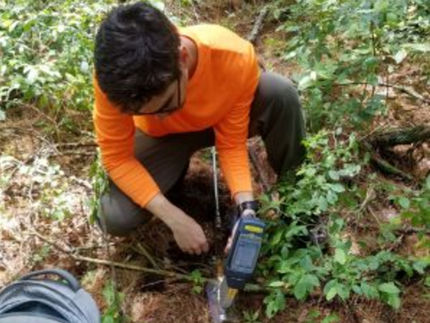Clean water from fog
A property known as photocatalytic memory ensures that this also functions when skies are overcast and at night
Researchers at the Max Planck Institute for Polymer Research and ETH Zurich are using a specially coated metal mesh to extract water from fog while removing environmental pollutants. People in dry but foggy areas could benefit.
It's already being done in Peru, Bolivia and Chile, but also in Morocco and Oman: In foggy regions, people set up nets on which the fog droplets settle, run down the meshes and can be collected. Up to several hundred litres of water for drinking, cooking, and washing can be obtained in a day with a fog collector measuring only a few square meters. In areas where there is a lot of fog, but hardly any spring or rain water, this is a blessing.
One problem, however, is air pollution, because pollutants also accumulate in the fog droplets. In many major cities around the world, the air is so polluted that water extracted from the fog there would not be clean enough to use untreated for drinking or cooking.
Researchers at the Max Planck Institute for Polymer Research and ETH Zurich have now developed a method that not only collects water from the fog, but also purifies it at the same time. To do this, they used a close meshed net, made out of metal wire and coated it with a mixture of polymers and titanium oxide. The polymers are selected in such a way that the water droplets are optimally deposited on the mesh and then flow as quickly as possible into a collection container so that they are not blown away again by the wind. Titanium oxide acts as a chemical catalyst. It breaks down many organic pollutant molecules contained in the droplets, rendering them harmless.
"By combining fog collection with water treatment, it can be used in regions with air pollution, for example in densely populated urban centers," says Ritwick Ghosh. He is a scientist at the Max Planck Institute for Polymer Research in Mainz, Germany, and carried out this research project during an extended guest stay at ETH Zurich in the group of Thomas Schutzius. During this time, he was a member of the group led by Thomas Schutzius, who has since taken up a post as professor at the University of California, Berkeley.
Photocatalytic memory
Once installed, the technology requires little maintenance and no energy other than sunlight. The titanium dioxide must receive regular UV light from the sun to regenerate. However, the catalyst is frugal: half an hour of sunlight is enough to keep it active for 24 hours. This has to do with property of titanium oxide called photocatalytic memory. When the substance is activated with UV light, it remains catalytically active for a longer period of time, even in the dark. Here, this proves to be a stroke of luck. Because where there is a lot of fog, the sun often doesn't shine for too long.
The researchers tested the fog trap in the laboratory and in a small pilot plant in Zurich. With it, they were able to collect 8 percent of the artificially generated fog and break down 94 percent of the organic compounds they added to the fog. Among the pollutants tested were ultra-fine diesel droplets and the hormone-active chemical bisphenol A.
Cooling towers as another application
In addition to drinking water, the technology can also be used to recover water from cooling towers. "In cooling towers, steam escapes into the atmosphere. In the U.S., where I live, we use a lot of fresh water for cooling power plants," Schutzius says. "It would make sense to capture some of that water before it escapes and make sure it's pollutant-free if you want to put it back into the environment."
Ritwick Ghosh's earlier research focused extensively on water recovery from cooling towers. He now wants to develop the technology further and look for marketable applications. In doing so, he hopes to make greater use of fog and steam as a previously underutilized source of water, helping to solve water scarcity.






























































